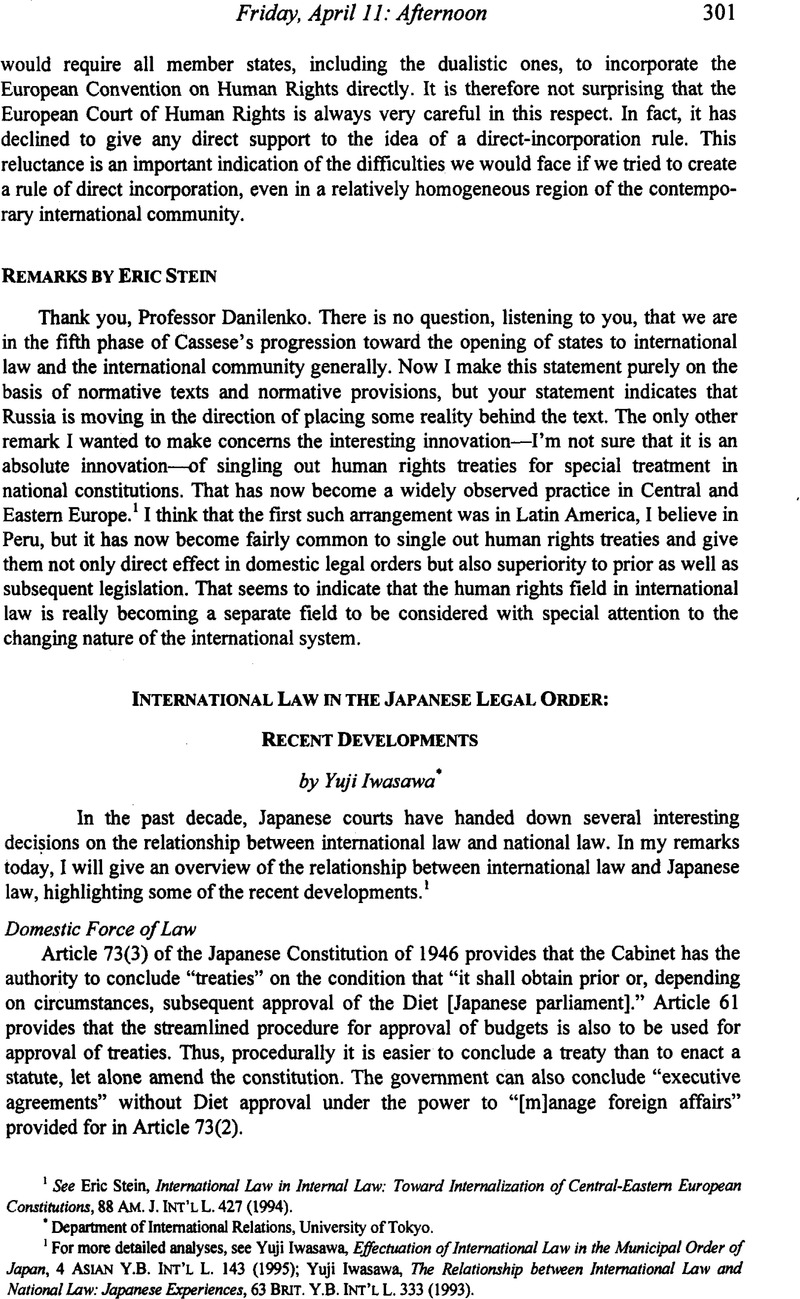No CrossRef data available.
Published online by Cambridge University Press: 28 February 2017

1 United Nations, Report of the Fourth World Conference on Women, U.N. Doc. A/Conf. 177/20 (1995).
2 Rebecca J. Cook, The Elimination of Sexual Apartheid: Prospects for the Fourth World Conference on Women 4-6, 23 (American Society of International Law Issue Papers on World Conferences No. 5, 1995).
3 See Charlesworth, Hilary, Women as Sherpas: Are Global Summits Useful for Women?, 22 Feminist Stud. 537 (1996)CrossRefGoogle Scholar; Dutt, Malika, Some Reflections on U.S. Women of Color and the United Nations Fourth World Conference on Women and the NGO Forum in Beijing, China, 22 Feminist Stud. 519 (1996)CrossRefGoogle Scholar; Looking At the World Through Women’s Eyes: Proceedings of the Plenary Sessions At the Ngo Forum on Women, Huairou, China (Eva Friedlander ed., 1995); Otto, Dianne, Holding Up Half of the Sky, But for Whose Benefit?: A Critical Analysis of the Fourth World Conference on Women, 6 Australian Feminist L. J. 9 (1996)Google Scholar; symposium issues of journals on Beijing; Issues Quarterly 2(1) 1996 and Women’s Studies Quarterly (1 & 2) 1996. For further references, see Rebecca J. Cook & Valerie L. Oosterveld, A Select Bibliography of Women’s Human Rights, updated periodically on the internet at: http://www.law.utoronto.ca/pubs/h-rights.htm.
4 Cook, Rebecca J. & Fathalla, Mahmoud F., Advancing Reproductive Rights beyond Cairo and Beijing, 22 Int’l Family Planning Persp. 115 (1996)CrossRefGoogle Scholar; Larson, Elizabeth L., United Nations Fourth World Conference on Women: Action for Equality, Development and Peace, 10 Emory Int’l L. Rev. 696 (1986)Google Scholar.
5 Schachter, Oscar, The Natures and Process of Legal Development in International Society, in The Structure and Process of International Law 745, 755 (Macdonald, R. St. J. & Johnston, D.M. eds., 1986)Google Scholar.
6 Id. 749.
7 Beijing Platform, para. 42.
8 Without Reservation: The Beijing Tribunal on Accountability for Women’s Human Rights (Niamh Reilly ed., 1996).
9 Byrnes, Andrew, Slow and Steady Wins the Race? The Development of an Optional Protocol to the Women’S Convention, 91 Proc. Am. Soc’y Int’l L. 384 (1998)Google Scholar.
10 Beijing Platform, supra note 7, para. 230(k).
11 Byrnes, Andrew & Connors, Jane, Enforcing the Human Rights of Women: A Complaints Procedure for the Women ‘s Convention, 21 Brook. J. Int’l L. 679 (1996)Google Scholar.
12 Beijing Platform, supra note 7, para. 46.
13 Id. para. 277(c).
14 Schachter, supra note 5, at 750.
15 Turpel, Mary Ellen, Patriarchy and Paternalism: The Legacy of the Canadian State for First Nations Women, 6 Can. J. Women L. 174 (1993)Google Scholar.
16 Crenshaw, Kimberle, Demarginalizing the Intersection of Race and Sex: A Black Feminist Critique of Antidiscrimination Doctrine, Feminist Theory and Antiracist Politics, 1989 Univ. Chi. Legal F. 139 Google Scholar.
17 Schachter, supra note 5, at 750.
18 Beijing Platform, supra note 7, para. 47.
19 Id.
20 Id.
21 An-Na’im, Abdullahi Ahmed, State Responsibility under International Human Rights Law to Change Religious and Customary Laws, in Human Rights of Women: National and International Perspectives 167 (Cooked, Rebecca J., 1994)Google Scholar.
22 Lisa Fishbayn, Gender Equality and the Rights to Culture in the New South Africa 4 (Feb. 13, 1997) (work in progress presented at the University of Toronto Faculty of Law).
23 Id. at 3.
24 Beijing Platform, supra note 7, para. 24.
25 Id. para. 26.
26 Schachter, supra note 5, at 751.
27 Id.
28 Otto, supra note 3, at 29.
29 Id. at 30.